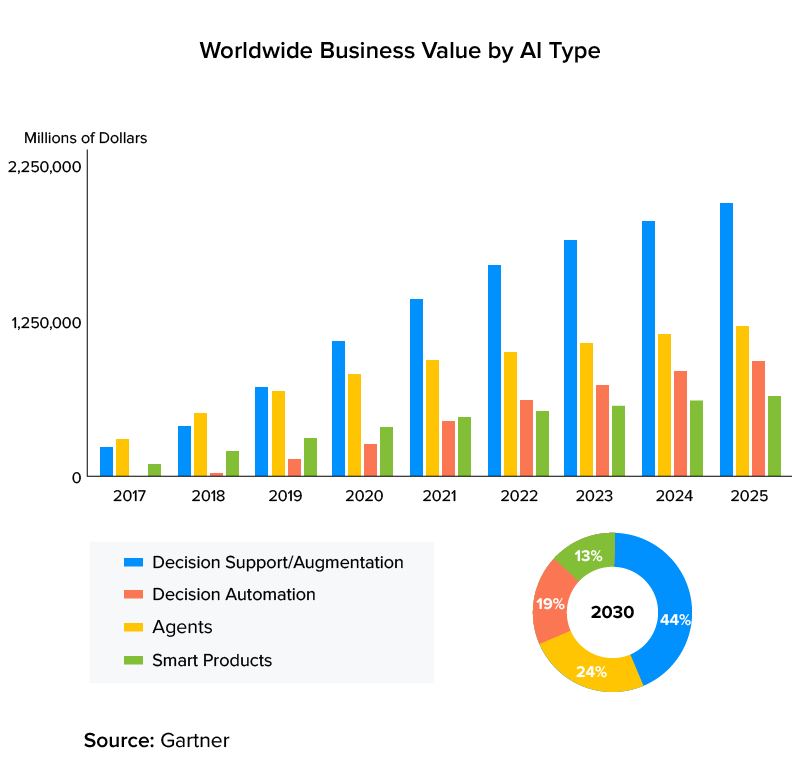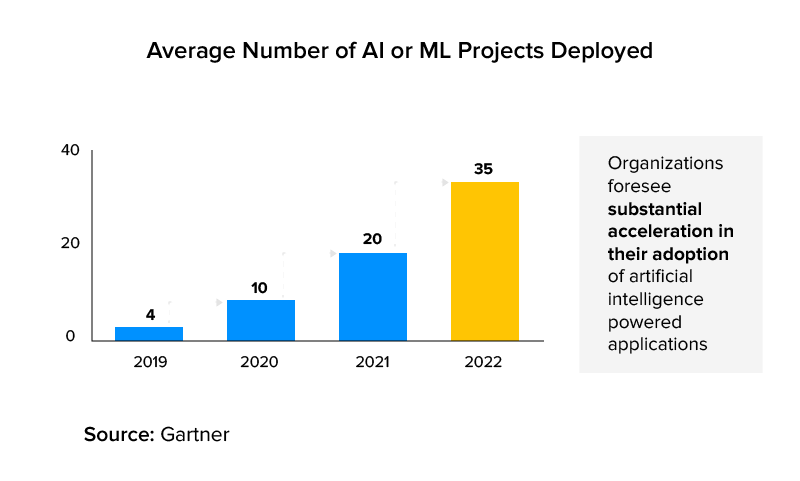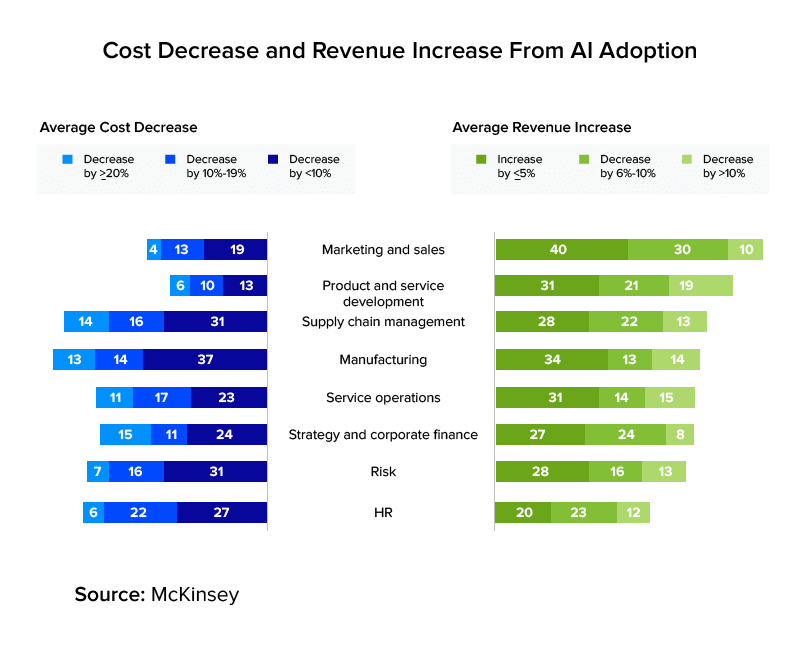Integrate AI Technologies To Help Companies Achieve Their Goals
AI is a marvel of modern science that has enabled many previously inconceivable possibilities. Many things in the industry have become more efficient and productive as a result of AI.
Talking about the role of AI in business, it has a wide range of applications in the commercial world. AI is affecting every business activity in various industries, from the commonplace to the spectacular. AI technologies are gradually becoming important for firms that are searching for ways to preserve a competitive advantage as they are widely available.
Below are some AI stats that are changing our business procedures.
- As per Fortune Business Insights, the global AI market for 2021 is $47.47 billion, which is expected to grow to $360.36 billion by 2028 at a CAGR of 33.6% during the forecast period.
- According to Gartner, the increase in usage of AI across businesses will create $2.9 trillion of business value and 6.2 billion hours of work productivity in 2021.
- Another Gartner forecast related to AI business value highlights decision support/augmentation as the largest type of AI by business value-add with the fewest early barriers to adoption. The forecast predicts that the decision support/augmentation will transcend other types of AI initiatives by 2030 to account for 44% of the global AI-derived business value.

- According to Forbes, 83% of businesses believe AI is a strategic priority for their business today.
- Despite the growing role of AI in business, many firms have development and implementation challenges, and these AI issues need to be solved. In this blog, you will get to know the six-step methodology for integrating AI technology and the benefits of AI in business that can help firms achieve their goals.
Now let’s dive into implementing technologies to achieve company goals.
AI Technology Implementation
1. Get familiar with technology
Companies must first identify which technologies execute specific types of activities, as well as their strengths and limits, before engaging with an AI program. For instance, some examples of artificial intelligence in business are, Robotic process automation and rule-based expert systems, which are both clear in how they work, but neither is capable of learning and evolving.
Deep learning, on the other hand, excels at extracting knowledge from enormous amounts of labeled data, but it’s nearly impossible to comprehend how it does it. This can be troublesome in highly regulated areas like financial services, where regulators demand to know why such choices are taken.
Several companies waste time and money by pursuing incorrect technology for the job. Companies, on the other hand, are better positioned to assess which technologies would best meet specific needs, which vendors to deal with, and how quickly a system can be implemented if they have a thorough understanding of the various technologies. Continuous research and education, usually inside IT or an innovation group, are required to gain this understanding.
2. Understand your business requirements
Review your business and decide which strategic pain points can be addressed using AI-based solutions. The first step is to figure out which parts of the company could gain the most from cognitive applications. AI in business can deliver predictive insights. It can assist you in automating processes. You can find out the goals of your company by examining them. They are usually portions of the firm where knowledge (insight gained from data analysis or a collection of texts) is in high demand but unavailable for some reason.
The next step to integrate AI is to establish an AI program is to conduct a thorough assessment of needs and capabilities, followed by the development of a prioritized project portfolio. Companies using AI should undertake assessments in three areas:
- Identifying the possibilities
- Assessing the use cases
- Choosing the appropriate technology
How hard is it to both technically and organizationally, implement the proposed AI solution? Would the advantages of launching the AI application in business be worth the time and effort?
Gartner conducted an online study through “AI and ML Development Strategies” survey. As per the survey, the average estimated number of AI projects in an organization was four in 2019, but respondents expected to include 15 projects within the next three years. This indicates that by 2022, the surveyed organizations expect to have an average of 35 AI or ML projects in place.

3. Prioritize the main drivers of value
You’ll need to determine the possible business and financial benefits of AI in business projects once you’ve established your company needs. Consider different implementations of AI and try to link each one to real results by focusing on short-term objectives and demonstrating the financial or business value as best you can.
As you consider your goals, keep in mind that value drivers (such as enhanced customer value or increased employee efficiency) are just as important as better company results. Consider whether machines, rather than people, could perform certain time-consuming tasks more efficiently.
The driving value examines whether the AI tools under consideration for each use case are genuinely capable. Some businesses may be frustrated by chatbots and intelligent agents, for example, because most of them can’t currently match human problem solving beyond simple programmed scenarios (though they are improving rapidly). Other technologies, such as robotic process automation, which might speed up simple procedures like invoicing, may slow down more complicated manufacturing systems.
4. Launching pilots
Firms should start with trial projects before rolling out cognitive applications across the organization as the difference between present and anticipated AI capabilities aren’t always evident.
Proof-of-concept pilots are especially designed for projects with high business value. They also allow the organization to test more than one technology at once. Take extra precautions to avoid project “injections” by senior executives who have been swayed by technology suppliers.
Consider establishing a cognitive center of excellence or equivalent structure to handle many pilots if your company plans to do so. This method aids with the development of necessary technical skills and competencies within the business, as well as the transition of small pilots into larger applications with higher effect.
In a survey commissioned by MemSQL on the adoption of artificial intelligence (AI) and machine learning (ML) in the workplace, 65% of respondents working, and preparing to use, ML/AI cited that the major point for adopting ML and AI was to enable more informed business decision making and underscoring the importance of these technologies for analytics.
5. Scale up
Many firms have successfully launched cognitive pilots, but they have not been as effective in the implementation of AI across the organization. Companies using AI need precise plans for scaling up to meet their objectives, which necessitates coordination between technology specialists and owners of the automated business process.
Scale-up is almost usually necessitated by integrating AI with existing systems and processes because cognitive technologies typically assist individual tasks rather than entire processes.
Companies should consider if the required integration is even practicable before beginning the scaling-up process. One of the examples of artificial intelligence in business is scalability which will be limited if the AI application in business relies on proprietary technology that is difficult to obtain. Make sure your business owners and IT team talk about scalability issues before or during the pilot phase. Even with relatively basic technology like RPA, an end-run around IT is difficult to succeed.
As per McKinsey’s survey about 33 AI use cases across eight business functions, the results suggest that AI is delivering meaningful value to companies. With over 44% of respondents it has been reported that cost savings from AI adoption in the business units where it’s deployed, AI adoption has decreased business units’ costs by at least 10%, on average. Respondents are likely to report revenue growth from AI use cases in marketing and sales, product and service development, and supply-chain management sectors.

6. Start small
When you’re initially starting, though, be judicious in how you apply AI in business, i.e. don’t throw all of your data at your first project and hope for the best.
Begin with a minor sample dataset and apply AI to demonstrate the value contained therein. Then, after a few victories, strategically roll out the solution with complete stakeholder support. You can then move on to seeing how well your AI works against a new dataset before putting it to work on data you’ve never seen before.
After confirming whether your initial plan was fit to scale (or if you needed to change your approach before moving forward), you can move from low-cost, low-risk projects to more ambitious initiatives: these early learnings could be vital for avoiding costly future blunders.
Frequently Asked Questions
Q1. How to build an AI?
A. Creating an AI system differs from standard computer programming in that software does not improve itself automatically. There are six major steps to keep in mind while building an AI.
- Identify the problem
- Prepare data
- Choose algorithms
- Train the algorithms
- Choose a programming language
- Run on a selected platform
Q2. How to use artificial intelligence?
A. In recent years, AI discoveries have been made thanks to advances in processing power, the availability of massive amounts of data, and innovative algorithms.
Artificial intelligence is seen as a critical component of society’s digital revolution, and future uses are projected to bring significant changes. Below are few industries where AI is bringing change.
- Voice recognition
- Healthcare technology
- Streaming services
- Chatbots
- AI in agricultural industry
- Manufacturing
- Transport
- Cybersecurity
Q3. How AI helps businesses?
A. Below are a few of the ways through which AI helps businesses to grow and monitor their progress:
- Sentiment analysis is an automated process that is used to monitor and analyze people’s emotions and opinions in different types of text.
- With Powerful Competitive Intelligence one can track everything your competitors do – from products to people to promotions and make the most informed decisions.
- Sales forecasts in AI allow you to see potential problems while you still have time to avoid them.
- With predictive analytics, AI converts information into knowledge and provides insight into the future.
Conclusion Note
Integrating AI into any firm is a major undertaking.
It needs in-depth knowledge, a lot of time, and a commitment to precision. Furthermore, instead of focusing on how AI can bring value to your specific business and determining where it’s most needed, focus on how AI can add value to your specific business and decide where it’s most needed to implement it successfully.
Then, with the help and knowledge of an artificial intelligence development company, you can put your AI business ideas to work and produce long-term value using AI’s challenging area.

strategies your digital product..





